Manufacturing Funding Boost Innovation with TIA Technology Innovation Agency
Manufacturing Funding: Boost Innovation with Technology Innovation Agency
Have you ever wondered how entrepreneurs can secure funding and investment support for their technological innovation and technology development projects in new enterprises under the following sectors: Advanced Manufacturing, Agriculture, Energy, Indigenous Knowledge Systems, Information and Communication Technology, and Natural Resources? This involves engaging with key stakeholders for the commercialisation of innovations.
In today's rapidly evolving technological landscape, technology development and innovations are crucial for entrepreneurs to stay ahead of the competition, enhance competitiveness, and seize innovative opportunities for commercialisation with key stakeholders. By utilizing technology stations, including technological innovations and investment support from high education institutions for small, micro, and medium enterprises, entrepreneurs can maximize their potential for success and competitiveness. That's where the Technology Innovation Agency comes in. This agency offers a range of funding opportunities and services for new enterprises, allowing entrepreneurs to source investments for technological innovations, commercialisation, and competitiveness through cooperation. These investments can fuel technological innovations and drive advancements in competitiveness for high education institutions, small, micro, medium enterprises in the manufacturing sector through funding application.
Securing funding for innovative opportunities in manufacturing is crucial to source investments for new enterprises, drive the commercialisation and exploitation of technological innovations, and enhance the competitiveness within the local technology innovation agenda. Semiconductor manufacturing enables manufacturers to invest in innovative opportunities, including technological innovation and source investments, cutting-edge technologies, research, and development, ultimately enhancing their products and processes and aligning with the local technology innovation agenda. It also plays a crucial role in the local technology innovation agenda, sourcing investments for innovations and the commercialisation of new ideas. The Technology Innovation Agency plays a pivotal role in supporting manufacturers by providing financial assistance and expertise to help turn their innovative opportunities in the energy sector into reality. With the support of the National Science Foundation (NSF), they are able to foster a skilled workforce that can drive advancements and technological innovation in energy technology.
Manufacturing funding not only benefits individual companies but also contributes to overall economic growth by creating innovative opportunities, supporting the local technology innovation agenda, and providing a skilled workforce in tech hubs. By promoting technological advancements, including the local technology innovation agenda, within the energy sector, it creates new job opportunities for the workforce, attracts investments, and boosts productivity as part of a phased programme. Moreover, these innovative opportunities in tech hubs have the potential to address societal challenges and improve our quality of life for the workforce, thanks to the support of NSF and alignment with the local technology innovation agenda.
We will explore how securing funding for innovative opportunities can lead to transformative changes within tech hubs, while driving economic progress and benefiting the workforce in the process. This phase of growth presents exciting prospects for the industry. So let's dive in!
Role of Technology Innovation Agency in Promoting Manufacturing Innovation
The Technology Innovation Agency (TIA) plays a crucial role in driving innovative opportunities within the manufacturing workforce through its mandate to support and promote technological advancements within the industry. This phase of TIA's work is supported by the National Science Foundation (NSF). By fostering collaborative efforts between the agency and manufacturers in every phase, funding projects that lead to innovative manufacturing processes, and facilitating partnerships with research institutions and technology providers, TIA has become a catalyst for transformative change in the manufacturing sector.
One of the primary objectives of TIA is to encourage collaboration between the agency and manufacturers in tech hubs during every phase. By working hand-in-hand with industry players in tech hubs, TIA ensures that its initiatives align with the needs and challenges faced by manufacturers in these tech hubs. This collaborative approach allows for a more targeted allocation of resources, ultimately leading to greater success in driving technological advancements within the manufacturing sector.
TIA's commitment to funding innovative projects has resulted in numerous success stories within the manufacturing industry, especially in tech hubs. Through financial support provided by TIA, manufacturers have been able to explore new technologies and develop groundbreaking solutions that enhance their production processes. For instance, one notable project funded by TIA involved the development of advanced robotics systems for assembly line automation in tech hubs. This project was supported by the CHIPS Act. This project not only increased efficiency in tech hubs but also improved worker safety by reducing human intervention in hazardous tasks.
Furthermore, TIA actively fosters partnerships between manufacturers, research institutions, and technology providers. These collaborations enable knowledge sharing and facilitate access to cutting-edge research findings and expertise in tech hubs. By bringing together different stakeholders from various sectors, TIA promotes cross-pollination of ideas and encourages an ecosystem where tech hubs can thrive. Such partnerships have proven instrumental in driving breakthroughs in areas like additive manufacturing, sustainable materials development, and smart factory technologies.
In addition to funding projects directly related to manufacturing processes, TIA also supports initiatives aimed at developing enabling technologies that benefit multiple industries. For example, TIA has invested in research on advanced materials such as graphene that have wide-ranging applications across sectors including aerospace, electronics, energy storage, healthcare, and tech hubs. This research is supported by the Chips Act. These investments not only contribute to the advancement of manufacturing but also have ripple effects in other industries, driving overall technological progress and economic growth.
Funding Instruments for Manufacturing Innovation
Manufacturers looking to innovate their operations can take advantage of various funding instruments offered by the Technology Innovation Agency (TIA). These tech hubs instruments, including grants, loans, and equity investments, provide crucial financial support to drive manufacturing innovation projects.
Grants: Fueling Innovation without Financial Burden
One of the primary funding instruments provided by TIA is grants. Additionally, TIA also supports the CHIPS Act, which aims to enhance domestic semiconductor manufacturing capabilities and secure the supply chain. Additionally, TIA also supports the CHIPS Act, which aims to enhance domestic semiconductor manufacturing capabilities and secure the supply chain. These non-repayable funds serve as a catalyst for manufacturers seeking to implement innovative solutions. Grants offer an excellent opportunity for companies to access financial support without incurring additional debt or interest payments. To be eligible for these grants, manufacturers must meet specific criteria outlined by TIA, such as demonstrating a clear need for innovation and presenting a well-defined project plan. The application process typically involves submitting detailed proposals that outline the intended outcomes and impact of the project.
Loans: Empowering Manufacturers with Flexible Financing
In addition to grants, TIA also offers loans as another funding option for manufacturing innovation projects. Unlike grants, loans require repayment over time but provide manufacturers with greater flexibility in terms of financing options. These loans can help cover various expenses related to research and development efforts, technology acquisition, or scaling up production capabilities. Eligibility criteria for loans may include factors such as creditworthiness and ability to repay the loan within specified terms. Manufacturers should carefully consider their financial capabilities before opting for this type of funding instrument.
Equity Investments: Partnering for Long-Term Success
For manufacturers seeking not only financial support but also strategic partnerships, equity investments present an attractive option. Through equity investments, TIA becomes a stakeholder in the manufacturer's business venture. This collaboration allows both parties to share risks and rewards while fostering long-term growth and sustainability. Manufacturers can benefit from TIA's expertise and industry connections while gaining access to essential funding. Equity investments typically require a thorough evaluation of the manufacturer's business model, market potential, and growth prospects.
Success Stories: Inspiring Innovations
The impact of TIA's funding instruments can be witnessed through numerous success stories in the manufacturing sector. Companies that have received grants, loans, or equity investments from TIA have been able to revolutionize their operations and drive significant advancements in their respective industries. For example:
- ARCi Technologies utilized a TIA grant to develop an automated production line, resulting in a 30% increase in productivity and a reduction in production costs by 20%.
- Vuhosi MedTech secured a loan from TIA to invest in state-of-the-art machinery, enabling them to produce innovative products with higher efficiency and quality.
- All-Weather Roads Engineering partnered with TIA through an equity investment, which not only provided financial support but also facilitated collaborations with industry leaders, leading to breakthrough innovations.
These success stories highlight the transformative power of funding instruments offered by TIA and encourage other manufacturers to explore these opportunities for driving innovation within their own operations.
Funding Opportunities for Natural Resources Sector
The natural resources sector, encompassing industries such as mining and forestry, plays a crucial role in the global economy. To encourage innovation and sustainability within this sector, the Technology Innovation Agency (TIA) provides specific funding opportunities for manufacturers operating in natural resources. These funding options serve as a catalyst for technological advancements that can revolutionize resource exploitation while minimizing environmental impact.
One of the notable funding opportunities offered by TIA is through grants. Manufacturers in the natural resources sector can access financial support to develop and implement innovative projects. These grants act as a valuable source of investment, enabling companies to explore new technologies and approaches that enhance efficiency and sustainability.
Several innovative projects within the natural resources sector have already received financial backing from TIA. For instance, companies focusing on waste management solutions have been able to secure grants to develop cutting-edge methods for reducing pollution and optimizing resource utilization. Initiatives aimed at water conservation and efficient extraction techniques have also received support from TIA's funding programs.
Investing in technology-driven solutions within the natural resources industry brings numerous benefits. By leveraging advanced technologies, manufacturers can streamline their operations, improve productivity, and reduce costs. Moreover, incorporating sustainable practices helps safeguard valuable resources for future generations while minimizing negative environmental impacts associated with resource exploitation.
Manufacturers operating in the natural resources sector should seize these funding opportunities provided by TIA to enhance their sustainability efforts and boost overall efficiency. By accessing financial support from TIA's grants program, companies can embark on transformative projects that address key challenges faced by the industry.
In order to leverage these funding opportunities effectively, it is crucial for manufacturers to collaborate with key stakeholders such as government agencies, research institutions, and private sector partners. This collaboration ensures that funded projects align with industry needs while benefiting from diverse expertise.
Furthermore, manufacturers should prioritize areas where technology-driven innovations can make a significant impact within the natural resources sector. Waste management solutions that minimize environmental harm, water conservation techniques, and efficient resource exploitation methods are areas that hold immense potential for positive change.
Funding Programs for Advanced Manufacturing Sector
The Technology Innovation Agency (TIA) offers dedicated funding programs specifically tailored towards advanced manufacturing companies. These programs aim to support and accelerate the development of cutting-edge technologies and improve production processes in the sector.
Overview of TIA Funding Programs
TIA has recognized the importance of technology innovation in the manufacturing industry, particularly in areas such as additive manufacturing, robotics, automation, and smart factories. To foster growth and competitiveness in these fields, TIA has established funding programs that provide financial assistance to eligible companies.
These programs offer grants or loans to support research and development activities, technology adoption, capacity building, and collaboration between industry players and research institutions. By providing access to funding resources, TIA aims to stimulate innovation-driven growth within the advanced manufacturing sector.
Key Focus Areas
TIA's funding programs focus on several key areas within advanced manufacturing:
- Additive Manufacturing: TIA recognizes the potential of additive manufacturing techniques such as 3D printing in revolutionizing production processes. Funding is available for companies looking to explore new materials, optimize designs, or enhance process efficiency using additive manufacturing technologies.
- Robotics: With advancements in robotics technology transforming various industries, TIA supports projects that leverage robotics for enhanced automation and productivity in manufacturing. Funding can be accessed for developing robotic systems or integrating existing solutions into production lines.
- Automation: Automation plays a crucial role in streamlining operations and improving efficiency in modern manufacturing facilities. TIA's funding programs assist companies seeking to implement automation solutions like programmable logic controllers (PLCs), computer numerical control (CNC) machines, or industrial robots.
- Smart Factories: The concept of smart factories integrates digital technologies into traditional manufacturing processes to optimize performance and enable real-time decision-making. TIA provides financial support for projects focused on implementing Internet of Things (IoT) devices, data analytics platforms, or artificial intelligence (AI) systems in manufacturing environments.
Success Stories
Numerous advanced manufacturing companies have already benefited from TIA's funding programs, resulting in remarkable success stories. These programs have enabled companies to push the boundaries of technology and enhance their competitiveness. Here are a few noteworthy examples:
- ARCi Technologies utilized TIA funding to develop a groundbreaking additive manufacturing technique that reduced production costs by 30% while improving product quality.
- Vuhosi MedTech received financial support from TIA, allowing them to create an innovative robotic system that increased their production capacity by 50% and improved overall efficiency.
- All-Weather Roads Engineering has invented a new building material with the assistance of TIA funding, resulting in a significant reduction in labor costs and enhanced productivity.
Collaboration Opportunities
TIA's funding programs also encourage collaboration between advanced manufacturing firms and research institutions. By fostering partnerships, these programs facilitate knowledge transfer, joint research projects, and technology commercialization. Companies can leverage the expertise of academic institutions or research organizations to accelerate innovation and gain a competitive edge.
Regional Programs and Skills Development for Innovation Funding
The Technology Innovation Agency (TIA) has implemented a range of regional programs to foster innovation in the manufacturing sector across diverse geographic areas. These initiatives are designed to address specific challenges and capitalize on innovative opportunities within each region, promoting growth and development. Furthermore, the agency places significant emphasis on skills development to enhance the capabilities of the manufacturing workforce.
One of the key objectives of TIA's regional programs is to bridge the innovation chasm that often exists between different regions. By tailoring their efforts to address local needs, they ensure that every region has an equal opportunity to thrive in the realm of innovation. This localized approach allows for a more targeted allocation of resources and enables manufacturers in various regions to tap into their unique strengths.
To achieve this, TIA actively collaborates with manufacturers, local communities, and educational institutions through its regional programs. These collaborations have proven successful in fostering a culture of innovation by bringing together diverse perspectives and expertise. For instance, manufacturers can leverage partnerships with local universities or research institutions to access cutting-edge knowledge and technology transfer. This cooperative approach not only benefits individual companies but also contributes to the overall growth of the region's manufacturing ecosystem.
Skills development lies at the core of TIA's commitment to enhancing innovation capabilities within the manufacturing workforce. The agency supports various training initiatives aimed at upskilling individuals and equipping them with relevant competencies needed in an increasingly technology-driven industry. By investing in workforce development, TIA ensures that manufacturers have access to skilled personnel who can effectively contribute to their innovative projects.
TIA's regional programs encompass a wide range of activities, including:
- Collaborative projects between manufacturers and science councils: These projects facilitate knowledge sharing and resource pooling between industries and scientific communities.
- Thought leadership initiatives: TIA organizes conferences, workshops, and seminars where industry leaders share insights on emerging trends and technologies.
- International institution cooperation: The agency actively engages with international institutions to foster cross-border collaboration and technology transfer.
- Skills development programs: TIA supports training initiatives that focus on developing technical skills, fostering creativity, and promoting entrepreneurship within the manufacturing sector.
By implementing these regional programs and prioritizing skills development, TIA plays a pivotal role in driving innovation in manufacturing across South Africa. Through collaborations and targeted initiatives, the agency ensures that each region can leverage its unique strengths while addressing specific challenges. This comprehensive approach not only boosts local economies but also positions South African manufacturers at the forefront of technological advancements.
Accelerating Manufacturing Technology through Investment Programs
The manufacturing industry is constantly evolving, driven by advancements in technology and the need for increased efficiency. To stay competitive in this rapidly changing landscape, manufacturers must embrace advanced manufacturing techniques and upgrade their technological infrastructure. Recognizing this need, the Technology Innovation Agency (TIA) offers investment programs that aim to accelerate technology adoption within the manufacturing sector.
One of the key benefits of these investment programs is that they provide manufacturers with access to much-needed capital. Upgrading technological infrastructure can be a costly endeavor, especially for small and medium-sized enterprises (SMEs). However, through the TIA's investment programs, manufacturers can secure funding to invest in state-of-the-art technologies without straining their financial resources. This access to capital enables them to enhance their production processes, improve product quality, and optimize resource utilization.
The success stories resulting from investments made through the TIA are numerous and inspiring. For instance, several manufacturers in the semiconductor industry have been able to leverage these programs to adopt cutting-edge technologies. By upgrading their equipment and implementing advanced manufacturing techniques, these companies have significantly improved their productivity and competitiveness on both local and global scales. The TIA's support has played a crucial role in enabling such transformations.
Private sector partnerships also play a vital role in leveraging these investment programs for mutual benefit. By collaborating with tech hubs and new enterprises, manufacturers gain access to a broader range of technological innovations. These partnerships facilitate knowledge exchange and foster an environment of innovation within the manufacturing industry. Furthermore, private sector involvement helps bridge the gap between research institutions and commercialization by providing real-world applications for emerging technologies.
Benefits of Manufacturing Funding with Technology Innovation Agency
In conclusion, manufacturing funding through the Technology Innovation Agency offers numerous benefits for businesses in various sectors. By partnering with the agency, companies can access funding instruments specifically designed to support manufacturing innovation. This includes funding opportunities in the natural resources sector as well as programs tailored for advanced manufacturing. Regional programs and skills development initiatives further enhance the potential for innovation funding.
The Technology Innovation Agency plays a crucial role in accelerating manufacturing technology through investment programs. By leveraging these resources, businesses can drive growth, improve competitiveness, and foster technological advancements within their industries. The agency's commitment to supporting innovation in manufacturing is evident through its diverse range of funding instruments and programs.
To take advantage of these benefits, we encourage you to explore the funding opportunities available through the Technology Innovation Agency. Whether you are a small startup or an established company, there are options that can help propel your business forward. Don't miss out on the chance to secure financial support for your manufacturing innovations and stay ahead in today's competitive landscape.
Application: How to apply for TIA funding
TIA funding applications has two options.
SOI – Statement Of Interest
SOI Documents: The applicant can prepare the required Legal Checklist information but will only be submitted at the full application stage.
Download Due Diligence Checklist
The documents below are only required at full application stage.
Download Financial Projections Template
Download Project Execution Plan
TIA Application Process

Step 1 – Applicant & Organisation
This is your initial start of the application & would require the following information.
1.1. Applicant Details
Begin the application process by providing essential information about the applicant. Clearly state the Project Sector, choosing from options like Advanced Manufacturing, Agriculture, Energy, etc. Precision is crucial, as TIA may re-categorize during the review stage if needed.
1.1.1. Advanced Manufacturing.
Specify the applicant's involvement in the Advanced Manufacturing sector, detailing how the proposed innovation aligns with TIA's mandate for funding within this category.
1.1.2. Agriculture
Clearly outline the role of the applicant in the Agriculture sector, emphasizing the relevance of the proposed innovation to TIA's funding criteria for this specific field.
1.1.3. Energy
Define the applicant's position in the Energy sector, highlighting the innovative aspects that make the project suitable for TIA funding within this category.
1.1.4. Indigenous Knowledge Systems
Detail the applicant's connection to Indigenous Knowledge Systems, explaining how the proposed innovation aligns with TIA's mandate for funding in this specialized area.
1.1.5. Information and Communication Technology
Clearly state the applicant's involvement in Information and Communication Technology, emphasizing how the proposed project meets TIA's funding criteria in this dynamic field.
1.1.6. Natural Resources.
Specify the applicant's role in the Natural Resources sector, elucidating how the proposed innovation falls within TIA's funding parameters for this category.

1.2.
Step 2 -Organisation Details
This section is your typical business details such as Organisation Name, Type, Physical Address, Tax number, contact number, website etc Furnish standard business details such as Organization Name, Type, Physical Address, Tax number, contact number, and website. If there are additional contacts, capture them in 1.2.2. This is especially pertinent for businesses with multiple co-founders or directors.
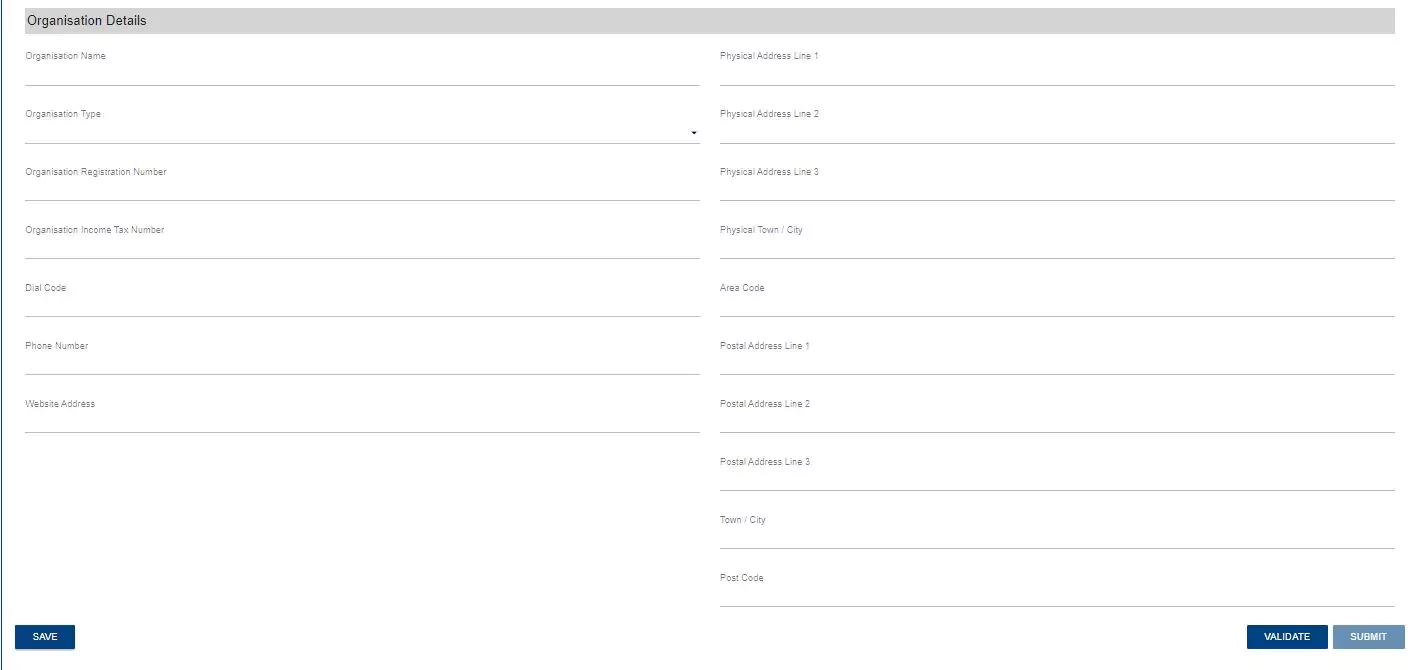
1.2.2. Additional Contacts
If applicable, provide details of additional contacts, such as co-founders or directors involved in the project. Include their names, roles, and contact information to ensure comprehensive application details.
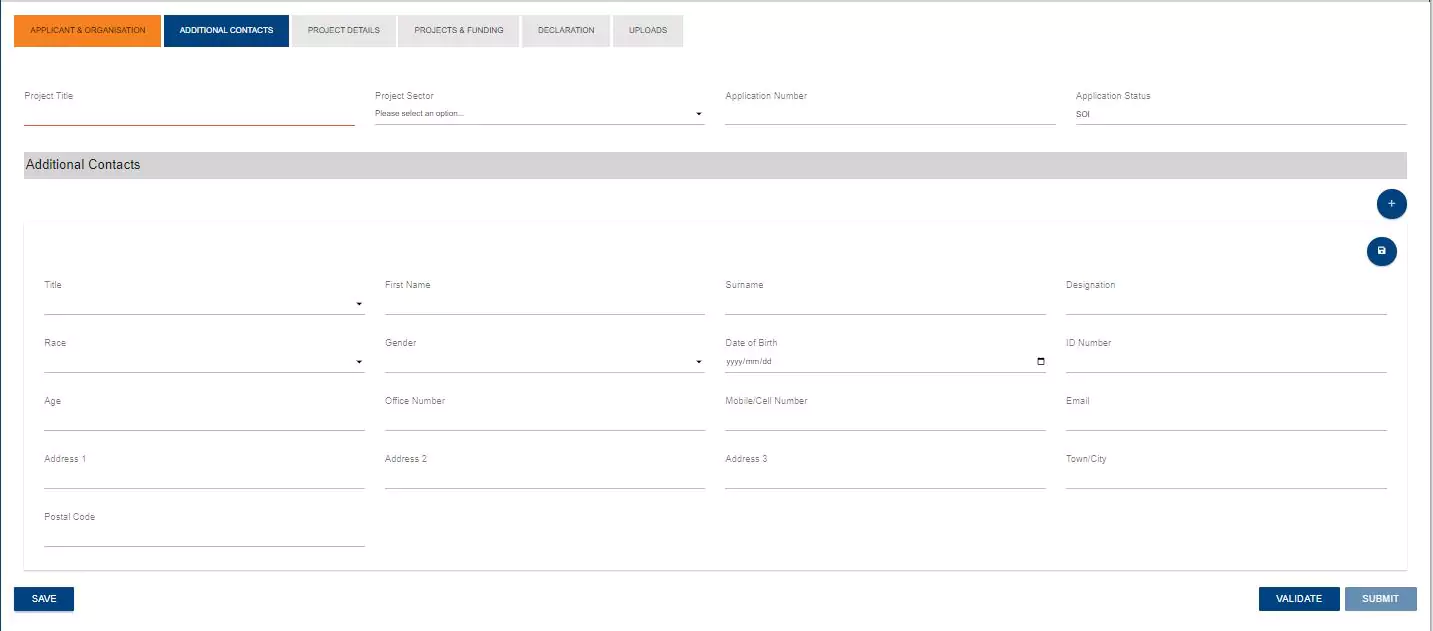
Step – 3 Project Details
Showcase your Proposed Technology Innovation with a precise pitch, defining your startup's stage within the chosen TIA mandate. Detail Intellectual Property with registration numbers, and address Commercial aspects, the Value Chain, and introduce your Team.
1.3.1. Proposed Technology Innovation
Present a concise pitch on the proposed technology innovation. Clearly define the startup's stage and elaborate on the problem the innovation addresses within the selected TIA mandate.
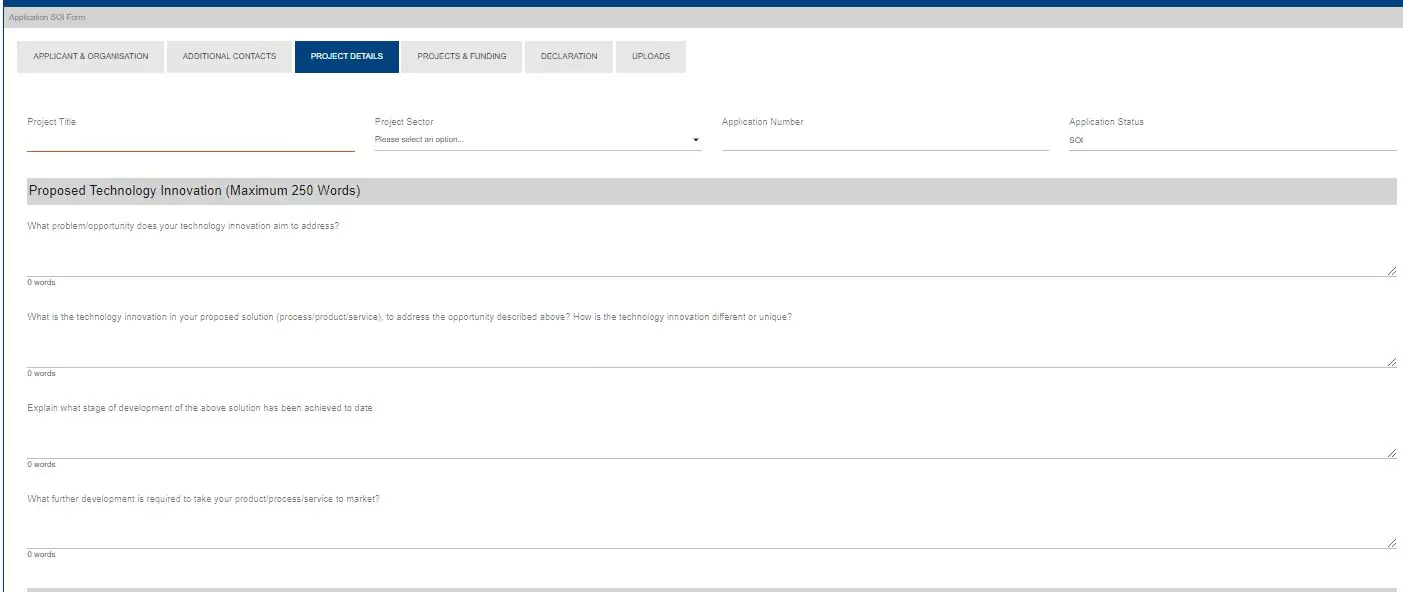
1.3.2. Intellectual Property
Define any intellectual property associated with the innovation, including registration numbers and certificates, demonstrating the uniqueness and protectability of the proposed technology.

1.3.3. Commercial
Address the commercial aspects of the project, outlining the potential market impact and revenue generation. Clearly articulate how the innovation aligns with TIA's goals for supporting commercially viable technologies.

1.3.4. Value Chain
Provide insights into the value chain of the proposed innovation, elucidating how it integrates into existing processes and contributes to the overall value creation within the chosen sector.

1.3.5. Team
Introduce the team members involved in the project, highlighting their relevant skills and experience. Emphasize how the team's composition contributes to the success and execution of the proposed innovation.

1.4. Projects And Funding
In this section, articulate Project Details, Co-Funding Details, Budget key Activities, and the overall Funding Total required for your innovation.
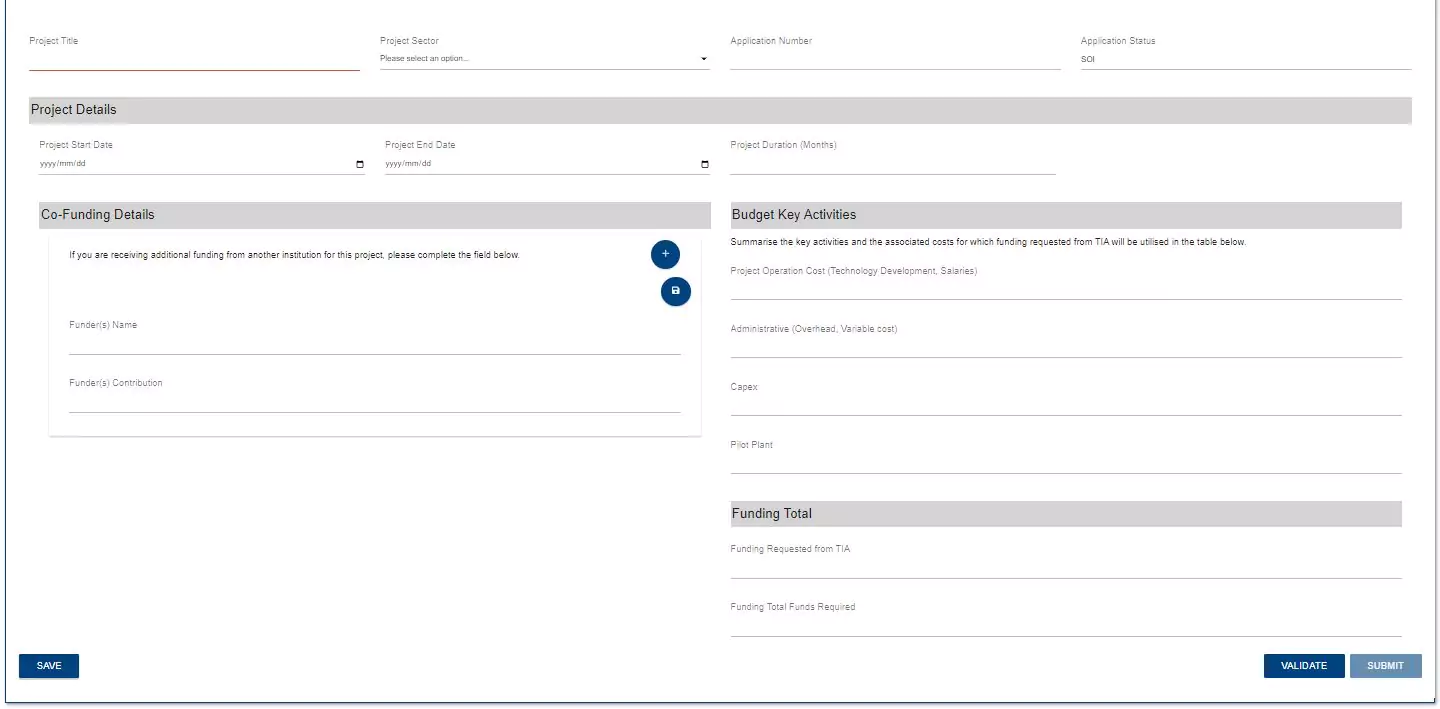
1.4.1. Project Details
Offer a comprehensive overview of the project, detailing its objectives, milestones, and expected outcomes. Clearly articulate how the project aligns with TIA's goals and contributes to technological innovation.

1.4.2.
Step 4 - Co-Funding Details
Outline any co-funding arrangements for the project, specifying the sources and amounts of additional funding. This provides a holistic view of the financial landscape supporting the innovation.
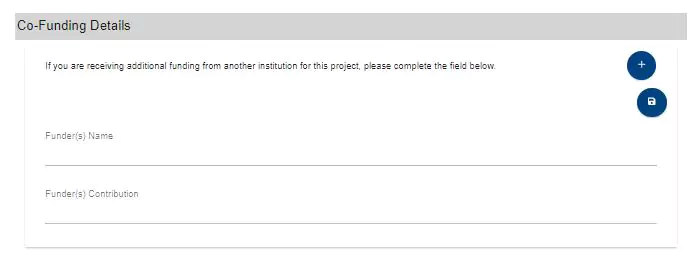
1.4.3. Budget key Activities
Break down the budget by identifying key activities and their associated costs. This detailed breakdown helps TIA assess the financial requirements for each project component.
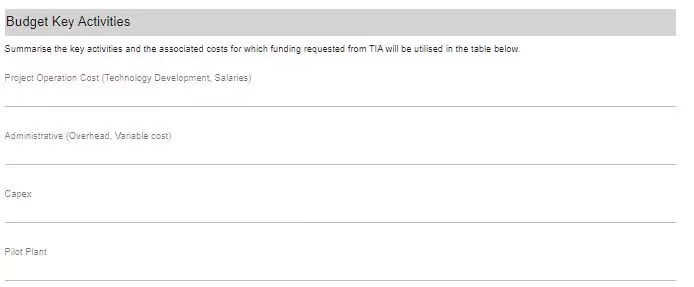
1.4.4. Funding Total
Clearly state the total funding amount required for the project. Provide a transparent justification for the requested funding, aligning it with the project's scope and expected outcomes.

1.5.
Step 5 - Declaration
Conclude by signing and accepting the declaration in 1.5.1, affirming your commitment to the provided information and the TIA funding process.

1.5.1. Sign and accept declaration
Affirm commitment to the provided information by signing and accepting the declaration. This signifies the applicant's adherence to TIA's guidelines and honesty in the application process.

1.6.
Step 6 - Uploads
1.6.1. Upload Documents
Complete the application by uploading essential documents. Include a Certified Identity Document and CIPC Document to ensure the verification of the applicant's identity and business registration.

1.6.1.1. Certified Identity Document
1.6.1.2. CIPC Document
GIP - Grassroots Innovation Programme
GIP Documents: Download the following document. Once completed, upload under the UPLOAD TAB in the application form.
Grassroots Innovation Programme Call for Proposal
Pitch Deck Template
FAQs
How can I apply for manufacturing funding with the Technology Innovation Agency?
To apply for manufacturing funding with the Technology Innovation Agency, you will need to visit their official website and navigate to the relevant section dedicated to funding opportunities. There, you will find detailed information on eligibility criteria, application procedures, and required documentation.
What types of projects are eligible for manufacturing funding?
The Technology Innovation Agency provides funding for various types of projects related to manufacturing innovation. This includes research and development initiatives, technology commercialization efforts, skills development programs, and collaborative projects between industry players.
Are startups eligible for manufacturing funding from the agency?
Yes! The Technology Innovation Agency supports both startups and established companies in accessing manufacturing funding. They recognize the importance of fostering innovation at all stages of business growth and offer specific programs tailored to meet the needs of startups.
How long does the funding application process typically take?
The duration of the funding application process can vary depending on factors such as the complexity of your project and the volume of applications received. It is advisable to check the Technology Innovation Agency's website for estimated timelines and any updates regarding processing times.
Can I receive multiple rounds of funding from the agency?
Yes, it is possible to receive multiple rounds of funding from the Technology Innovation Agency. However, each application will be evaluated on its own merits, and approval for subsequent rounds will depend on factors such as project progress, impact, and alignment with agency objectives.



